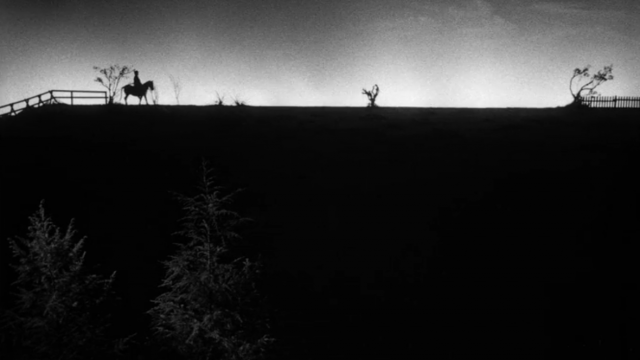Robert Mitchum’s performance in The Night of the Hunter, as the reverend Harry Powell, flies dangerously close to camp. So it’s the perfect emblem for the inner workings of this film. His southern drawl is exaggerated to borderline caricature, as cardboard as the antebellum sets behind him. His face contorts in truly monstrous ways, accentuated by the streaks of creepy light, courtesy of Stanley Cortez’ cinematography. In one brilliant image, after stalking two children down into a basement, looking horrifying in the creepy frame given to him by director Charles Laughton, he gets his hands smashed by a board on the stairs, and in pain he carries his hands in an arched grasping motion; he looks just like Frankenstein. It’s a dizzyingly funny image, just after a frightening one. Mitchum understands how thin the line is between humor and horror. So does Laughton.
But for all its exaggeration, The Night of the Hunter is not camp. It’s certainly melodramatic, but you couldn’t quite call it a capital-M Melodrama either. This is one of the film’s greatest thrills: just as you think you’ve pinned down its genre, Laughton takes another left turn. The plot, at least for the first half, is archetypical noir: there’s some stolen money that everyone’s after, and nobody will stop lying and cheating to get it. In some frames, the shadows and artful silhouettes of Mitchum could trick you into thinking you’re watching, say, Out of the Past. But ask yourself how many noir films take place from a child’s point of view? Indeed, in the star-spangled opening, with choirs of children singing and a book of fables being opened by Lillian Gish, we’re introduced to a children’s fairy tale, a fable that borders on the biblical. In some frames, particularly in the children’s house, on the first night after the marriage of Powell and the mother, the acute geometry could come straight out of a German expressionist film.
Few films announce their brilliance as quickly as this: the opening credits, over a starry night, introduce Mitchum’s name first with pounding brass, announcing him like the monster in a monster movie. But not ten seconds after this grand instrumentation, the choir of children begin singing, “Dream, little one, dream.” We’re greeted by the disembodied torso of Lillian Gish, who begins to speak about the Bible to an attentive audience of disembodied children’s heads, up in the stars. She speaks of the pure at heart, and the false prophets, wolves in sheep’s clothing. We then take a look, from our God’s-eye perspective, at some children playing hide and seek, discovering a dead woman’s body in the cellar. The contrast couldn’t be clearer: the innocence of childhood is being corrupted by the evils of society.
We’re introduced to Powell. In Mitchum’s audition for the part, Laughton described Powell as “a diabolical shit,” and Mitchum replied “present!” Laughton displays clearly the nature of Powell, who drives along the road, talking to ‘God’ about his mission to kill another widow. Laughton shoots this scene from the side, Powell drives in profile and looks up at the sky to speak to the Lord. Laughton’s camera has a God’s eye perspective, and so we can truly know that he’s speaking to the wrong place, unlike Gish, who speaks directly into the camera, staring God in the eye. Laughton displays the nature of every character in precise focus; we always know which trees will bear good and evil fruit. This is not simplistic, it’s authoritative. Since he shares his perspective with the children for most of the film, seeing Powell through their eyes, Laughton suggests that children see Powell the way God sees him: as a wolf in sheep’s clothing. Children and God look at the world in a similar way, it seems.
This film isn’t about the machinery of plot, nor about the intricacies of character. Rather, it’s about imagery, and there are many images from this film that will burn into your brain forever. If you’ve seen the film, you’ll know what they are: a woman underwater, animals watching children travel down the river, Lillian Gish sitting on the porch with her shotgun, Powell on a horse, Powell by the lamppost, an angry mob, a Christmas tree. This is not a film where we can think of the story apart from the images, or comment on the cinematography. It’s not only descended from the silent film tradition –with its Caligariesque set design, its Murnau-descended approach to light and darkness (figuratively and literally), and its grand parabolic imagery straight out of Lang’s films– it’s perfectly functional as a silent film.
…But if it were silent, you’d miss out on Mitchum’s singing voice (and you’d also miss out on a lifetime of nightmares). If you think his Southern drawl is creepy, wait until you hear it sing “Bringing in the Sheaves.”
This film is truly singular. Singular in performance and tone, singular in its gorgeous cinematography, singular in its placement in the canon of classic film. It takes its influence from the twenties and forties, it’s set in the thirties, yet it lands smack in the middle of the fiftiess, where it was truly unwelcome. In the career of director Charles Laughton, it’s literally singular: its critical and financial failure ensured he would go back to acting, tail between his legs, never to direct another masterpiece of this kind. Not only is it singular, it’s irreducible. It’s impossible to isolate anything from this film without breaking it apart. To talk about any one element, you’ve got to talk about all the rest. It’s a whole of disparate elements that truly shouldn’t fit together, but by some divine miracle, they do.
How unfortunate then that the evil adult world couldn’t see this film for the masterpiece that it is. If the world was just, Laughton would’ve made many more fantastic films. Thank God we have one.

